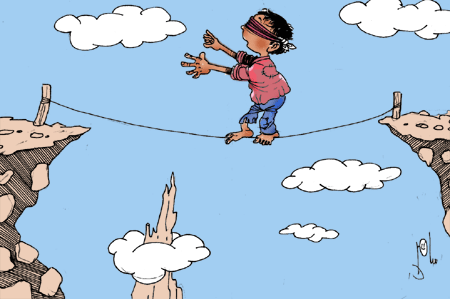
Poverty and family disputes are among the main factors behind it: Horrific facts on street children in Yemen [Archives:2003/04/Culture]
January 27 2003

BY YASSER AL-MAYASI
YEMEN TIMES STAFF
ym_almayasi@yahoo.com
Children are the hope of a brighter tomorrow and the joy of today. But the seeds of the future are sometimes planted and grown in the worst circumstances, forced by cruel fate to exist in circumstances far from secure and decent life.
An alarming number of Yemeni children from various regions are born into the streets and have no place to call home. Factors such as war, epidemics, and poverty have influenced this number to grow every day. And hence, a phenomenon called street children came to view, causing a threat to the social security of the region and many other problems in the Yemeni society. This is an investigative report focusing on the phenomenon and analyzing the situation with input from concerned parties.
Ms Suad Al-Qadasi, Chairperson of the Women’s Forum for Research and Training (WFRT) said: “Although the issue of street children has been existing since a very long time, it came to people’s attention only recently. This is mainly a consequence of the deterioration of living standards in the country; the poor level of living conditions and the high poverty rate resulted in turning innocent child into victims of violence from his/her own family and from outsiders. The child in question goes off track and becomes a threat to the society as a whole and even to him/herself. Children living in unhealthy circumstances are vulnerable to attacks in all forms and ways. They are often exposed to abuse and beaten up and sometimes even g through sexual molestation. The way to tackle these issues is through raising awareness in the community and providing a decent income to poor families as well as enforces the law when a crime is committed.”Mr. Abdullatif Al-Hamadani from the Media and Awareness department at the Supreme Council for Mother and Child says: “Street children are a phenomenon is a direct consequence of poverty. It is also neglected because of social, educational, and other reasons. Many factors come together to contribute in this issue and they differ from one country to another. Sometimes more than one factor jointly causes this phenomenon to flourish. For example losing both parents does not necessarily drive a child to the street, whereas with both parents there and family violence existing, it is likely to that children may want to leave the house and become street children.”
According to Mr. Al-Hamadani, the main factors behind this phenomenon can be summarized in the following:
-Poverty: Statistics indicate that at least 35% of the population lives below poverty line. A large percent of those poor Yemenis live in the suburbs. Unemployment is more than 30%. Unemployment levels reached their peak following the Gulf crisis when Yemeni migrants in the Gulf headed back to Yemen causing a burden on the national economy. Poverty could create psychological complexes and child of poor families become victims of the tough circumstances they live in and set off to the streets searching for ways to find alternatives.
-Weak family relations: Violence at home, polygamy, divorce and the death of a parent are all factors that contribute to tense and weak family relations which eventually cause children to run away from home or learn bad behavior.
-Dropping out of school: Another reason why children end up in the streets is that they did not like it elsewhere including the school. Sometimes the system of education in schools or teachers’ treatment of students turn children off and make them decide to run away from school or at least become truants Sometimes it’s the bad company that results in this phenomenon. In other situations children are forced out of school by their own parents in order to support the family financially by working to make ends meet. When the child shoulders the responsibility in an early age with no guidance, he/she could turn to illegal ways to earn money and eventually develop a criminal record.
Researcher Walid Gahzar, talked about the relative relation between poverty and increase of street children saying: “To start with, we must realize that poverty is an outcome of a number of political, developmental and economical elements in underdeveloped countries. And when poverty dominates a certain sector of life or society, it produces negative symptoms such as street children, illiteracy, and social violence… etc. But a vital element that most studies fail to cover in such issues is that women are the basis for the cure of such social diseases because they are the most influential factor when it comes to children. Women in developing countries are less fortunate when it comes to finding a job or making a living, and hence young girls are forced in most cases to make ends meet through prostitution or other degrading means. Other reasons that may force girls to the street may not be economical. Statistics indicate that 51.4% of the child labor market is composed of females. This is due to the fact that women in most developing countries take up domestic or farming duties such as in agriculture or selling food products. Also most women are not encouraged to study in schools especially in the suburbs, due to the school expenses and the traditions that view education for women and sometimes for men as luxury. What is noticed, is that street girls are more liable to abuse and violence than street boys, and this class of society is the least privileged and most deprived in health and education.
Psychology specialist Ms. Jamila Mohammed Nasser added that although street children face sexual abuse, there are no official statistics on this issue. Mr. Nasser carried out a field survey on sexual molestation of children and found out that such incidents happen through attraction and fooling of the child in order to lure them into something and then take advantage of their weakness. She defined sexual child molestation as a forceful sexual intercourse between an adult and a child. The study disclosed that children are abused in most cases by relatives, and that they are trapped in situations where they cannot tell what is happening to them. In many cases the child becomes confused on how to react to sexual molestation because in the same time he would expose himself to punishment of the abuser. However, these incidents leave long lasting marks in the child’s psychology, which he carries with him to the future and affects him or her whenever he tries to start a family or becomes an adult.
She emphasized that girls develop fear of men and lose confidence in themselves and sometimes refrain from marriage and normal relationship with men because of the fear that their husbands may find out about their lost virginity. Some abused kids become homosexual as time passes because they find security in their own gender.
As for males, she said that most boys who are molested become gays and eventually turn to abuse younger boys whom they interact with.
Ms. Naser pointed out that it is very important to lay down an encapsulating overall national strategy that limits the phenomenon of street children and enforces relevant laws against child abusers especially when sexual abuse. In the same time however, she called for the creation of rehabilitation centers and institutes for those victims. She also stressed on the importance of awareness and religious values that instate faith and moral beliefs in all levels of the society. Moreover, she urged the concerned authorities to give the topic what it deserves of research and studies in order to be able to address this problem in the right way.
A filed survey was carried on street children in Yemen by the Communication Psychology specialist and researcher Abdulrahman Abdulwahab Ali and was supervised by WFRT. In the survey, Mr. Abdulrahman discussed this phenomenon and its different aspects and causes. He focused on the attractions that those children find in the street and if their needs are met. The study revealed that there is no major gap between the ratios of street children to normal children in all the districts mentioned in the survey. It also said that most of those children were forced into the street because they became the supporters of their families. The survey also found out that from the sample of children they took, a majority of 78.6% was males, and that 47.1% of street children did not enroll in schools at all. 38.6% of the children beggars in the street are there because of dire need for money, and those have traveled from their original hometown looking for ways to make a living.
The study also disclosed that street children are mainly divided into four segments, street vendors, laborers in workshops and farmers. Out of those children, 28.6% do not return home on a regular basis and they mostly live in the streets in huts or street shelters. The study disclosed that 95.3% of gang fights are among street children because of their unsettled circumstances and status of insecurity and deprivation.
One can conclude that the phenomenon of street children remains a serious and devastating problem that is causing outrageous consequences on Yemen’s own future. But what is even more serious is the fact that the phenomenon is in the rise.
Many donor countries and establishments have continuously pointed to this problem and offered to hold seminars, workshops, etc. But there has been no solid move to start a rehabilitation center or make field surveys to investigate why this is happening.
The solution now is to stop theoretical debates and start practical solutions in order to save the next generation from a horrid future. Governments, NGOs and individuals should work together in order to combat this phenomenon and provide suitable conditions for the children to live in.
Our children are our future, let us not waste time dwelling in the other less significant issues of the past and start working on our future, and our children’s future.
Captions:
-Internal family disputes and rough treatment of parents are one of the reasons behind driving children to the street.
-Abused girls develop a strong fear of men and may turn to homosexual relations looking for security, while and abused boys become violent introverts and abuse younger children in turn.
-47.1% of street children did not enroll in school at all. 38.6% of children beggars in the street are there because of dire need for money.
-Poverty, Poor family relations, and dropping out of school are factors contributing to the increasing number of street children.
——
[archive-e:04-v:2003-y:2003-d:2003-01-27-p:./2003/iss04/culture.htm]


